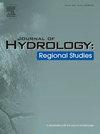Spatiotemporal variations and drivers of runoff in China based on a high-quality continuous runoff dataset
IF 4.7
2区 地球科学
Q1 WATER RESOURCES
引用次数: 0
Abstract
Study region
China.
Study focus
Hydrometric gauge networks across China provide inadequate records for comprehensive natural runoff monitoring. Here, we utilized the China Natural Runoff Dataset, a high-quality, continuous runoff dataset, to elucidate the spatiotemporal variations and key drivers of runoff across China from 1982 to 2015.
New hydrological insights for the region
We identified a distinct southeast-to-northwest gradient in runoff distribution. Significant runoff increases in northwest China and declines in central China have collectively shifted the runoff gravity center northwestward. Multiple linear regression analysis reveals that precipitation is the dominant driver of runoff variations across 90 % of the country, with high coefficients of determination ( > 0.4, p < 0.05). Significant positive correlations between runoff and precipitation are observed across all river basins, with correlation coefficients ranging from 0.77 to 0.95 (p < 0.05). Vegetation cover and air temperature are the leading factors that influence runoff both positively and negatively in 5.5 % and 4.5 % of the grids, respectively, mainly in the Continental River basin (CRB) and the Yellow River basin (YRB). In CRB, rising temperatures may increase evaporation and exacerbate soil moisture deficits, leading to reduced runoff, or alternatively may enhance glacial snowmelt and thereby increase runoff. In YRB, human-driven vegetation restoration efforts around 2000 significantly reduced runoff, whereas notable increases in runoff post-2000 are likely attributed to substantial rises in precipitation.
研究地区中国.研究重点中国各地的水文站网无法提供全面的天然径流监测记录。在此,我们利用中国天然径流数据集这一高质量的连续径流数据集,阐明了 1982 年至 2015 年中国各地径流的时空变化和主要驱动因素。西北地区径流量的显著增加和华中地区径流量的减少共同导致了径流重心向西北方向移动。多元线性回归分析表明,降水是全国 90% 地区径流变化的主要驱动因素,具有很高的决定系数(R2 > 0.4, p <0.05)。所有流域的径流与降水量之间都存在显著的正相关关系,相关系数从 0.77 到 0.95 不等(p <0.05)。植被覆盖率和气温分别在 5.5% 和 4.5% 的网格中对径流产生正向和负向影响,主要集中在大陆河流域(CRB)和黄河流域(YRB)。在大陆河流域,气温升高可能会增加蒸发,加剧土壤水分不足,从而导致径流量减少;或者可能会促进冰川融雪,从而增加径流量。在长江上游地区,2000 年前后人为的植被恢复工作大大减少了径流量,而 2000 年后径流量的显著增加可能是由于降水量的大幅上升。
本文章由计算机程序翻译,如有差异,请以英文原文为准。
求助全文
约1分钟内获得全文
求助全文
来源期刊

Journal of Hydrology-Regional Studies
Earth and Planetary Sciences-Earth and Planetary Sciences (miscellaneous)
CiteScore
6.70
自引率
8.50%
发文量
284
审稿时长
60 days
期刊介绍:
Journal of Hydrology: Regional Studies publishes original research papers enhancing the science of hydrology and aiming at region-specific problems, past and future conditions, analysis, review and solutions. The journal particularly welcomes research papers that deliver new insights into region-specific hydrological processes and responses to changing conditions, as well as contributions that incorporate interdisciplinarity and translational science.
 求助内容:
求助内容: 应助结果提醒方式:
应助结果提醒方式:


